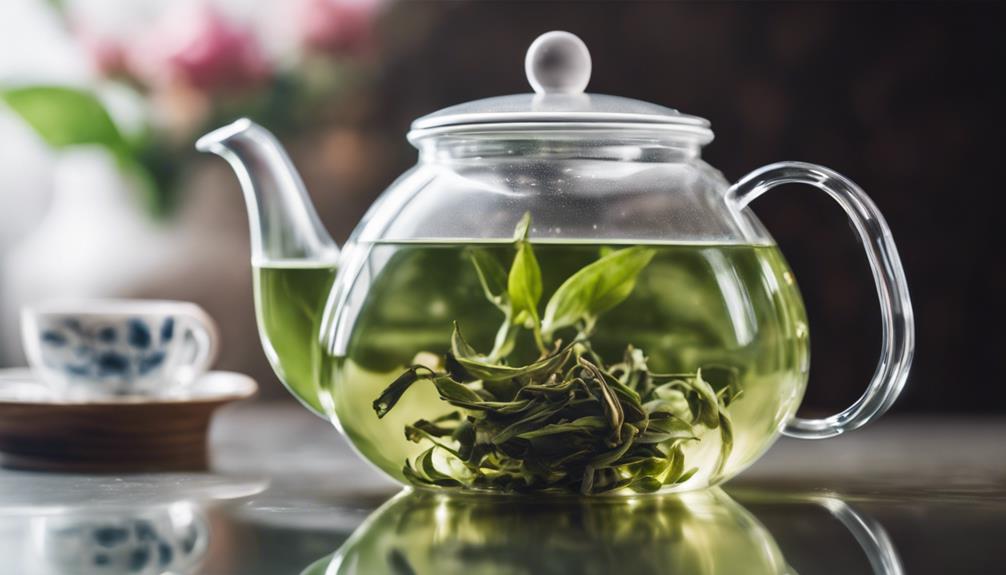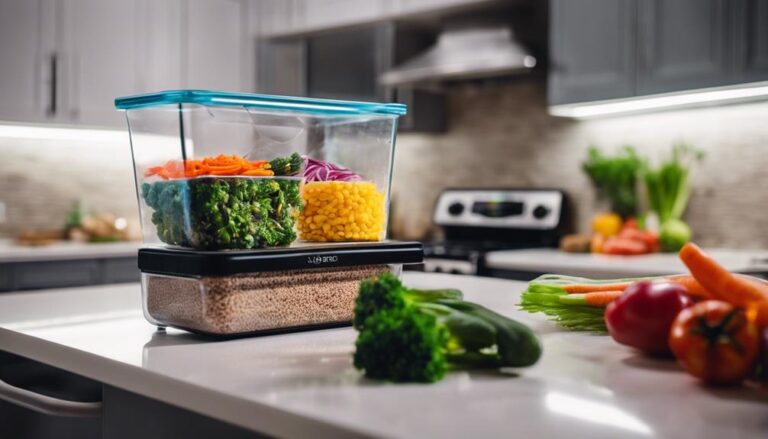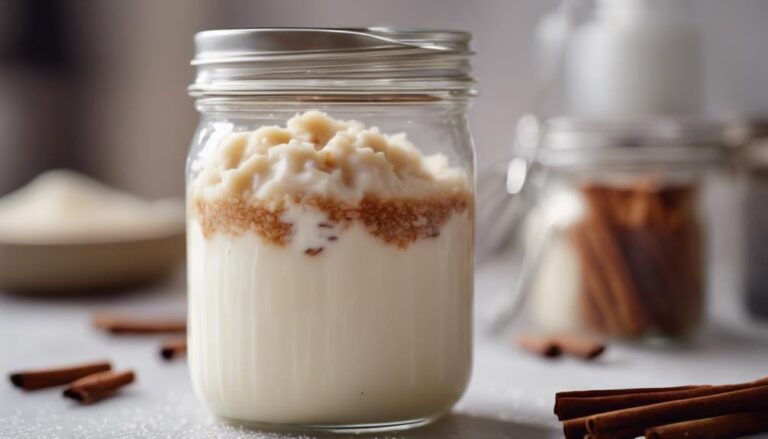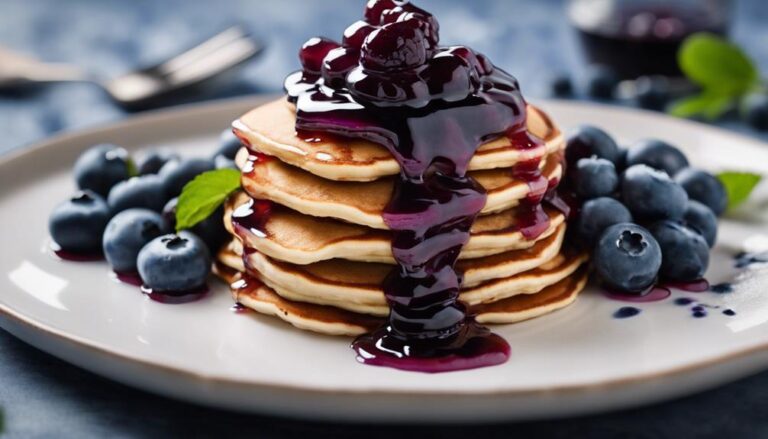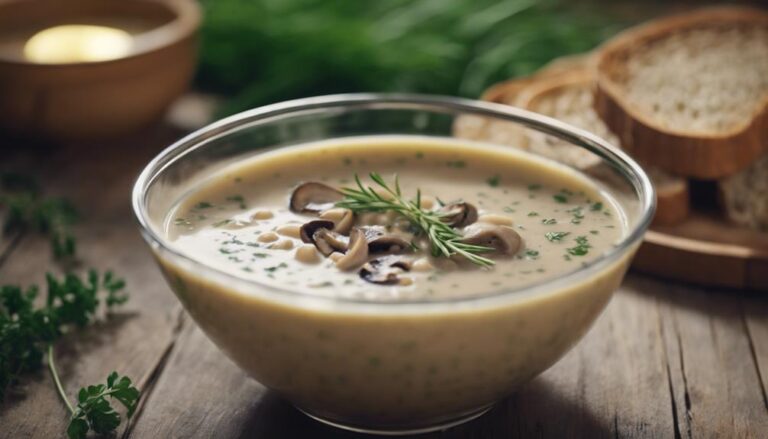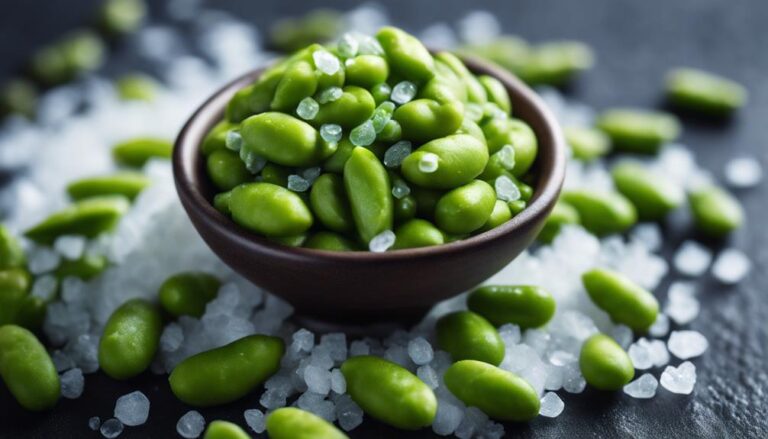Sous Vide Green Tea With Jasmine
Experience the accuracy of sous vide for Sous Vide Green Tea with Jasmine. Maintain a constant 175°F for ideal extraction, avoiding flavor inconsistencies. Sous vide technology guarantees consistent temperature regulation, enhancing your tea-drinking ritual. Guarantee delicate flavors shine through with a 2-3 minute steeping time. Delve into the world of precise flavor extraction and aromatic bliss.
What You Will Learn Here
- Sous vide method ensures precise temperature control for perfect jasmine green tea extraction.
- Gentle sous vide technique preserves delicate flavors of jasmine and green tea.
- Slow infusion process maximizes aroma without bitterness in jasmine green tea.
- Consistent results eliminate risk of over-extraction and bitterness in sous vide brewing.
- Enhanced floral aroma and balanced tannins create a superior tea-drinking experience.
Tea's Evolution Timeline
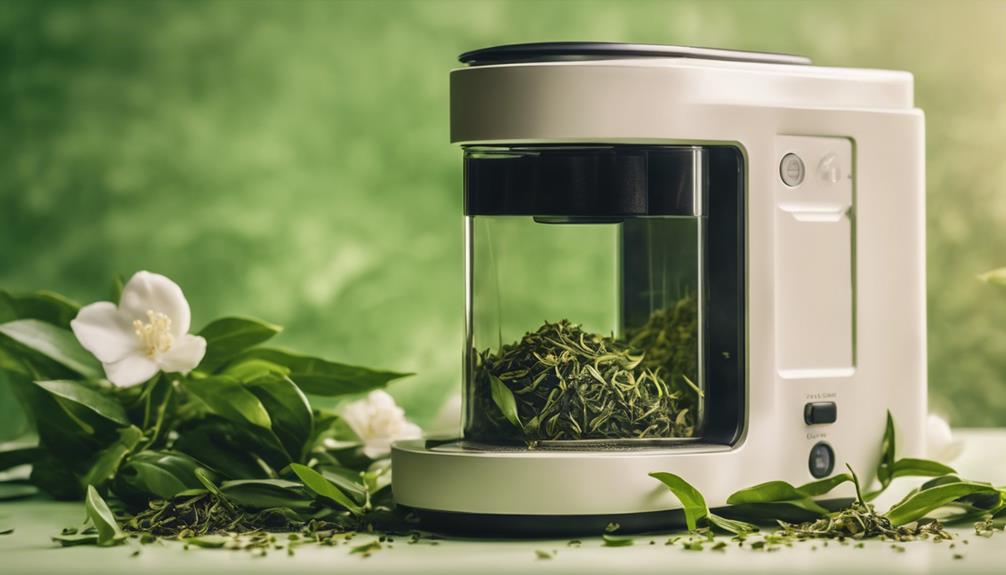
Tea's history spans over 5000 years, beginning in China with the legendary Emperor Shen Nong around 2737 BC.
As tea made its way to Japan, Europe, and eventually India, its cultivation and consumption evolved.
Today, the global tea market offers a diverse array of types and flavors, showcasing the rich timeline of tea's journey through various cultures.
Tea History Overview
Emerging over millennia, the development of tea, from its ancient roots in China to its global prominence today, traces a fascinating timeline of cultural diffusion and transformation.
Tea was first discovered in China around 2737 BC by Emperor Shen Nong, eventually spreading to Japan in the 9th century and Europe in the 16th century.
The East India Company played a pivotal role in popularizing tea in England during the 17th century.
The Boston Tea Party in 1773 marked a significant event in American history related to tea.
Throughout history, tea has evolved from being a luxury item to becoming a widely consumed beverage worldwide, with a multitude of diverse varieties and preparation methods contributing to its enduring popularity.
Jasmine Tea Origins
How did jasmine tea originate and evolve within the timeline of tea's development? Jasmine tea has its roots in China, dating back to the Song Dynasty around the 5th century. The introduction of the jasmine plant from Persia for its aromatic flowers marked the beginning of jasmine tea production. It wasn't until the Ming Dynasty in the 14th century that jasmine tea production expanded, gaining popularity for its floral fragrance and delicate taste. The process of scenting green tea with jasmine flowers became a traditional practice in Chinese tea culture. Below is a table summarizing the key points in the evolution of jasmine tea within the broader history of tea:
| Time Period | Key Events |
|---|---|
| 5th Century | Jasmine tea originated in China |
| 14th Century | Production of jasmine tea expanded |
| Ming Dynasty | Jasmine tea gained popularity |
| Song Dynasty | Introduction of jasmine plant to China |
| Chinese Tea Culture | Scenting green tea with jasmine flowers |
Modern Tea Trends
Investigating the evolution of modern tea trends reveals a dynamic interplay of tradition and innovation shaping the global tea landscape.
One notable trend is the emergence of electric tea kettles, revolutionizing the way tea is brewed. These kettles offer precise temperature control, ensuring each tea variety is brewed at its ideal temperature for the perfect infusion.
Additionally, electric tea makers have gained popularity for their convenience and efficiency, automating the brewing process and allowing tea enthusiasts to enjoy their favorite blends with ease. This technological advancement has streamlined the tea brewing experience, catering to the fast-paced lifestyle of many individuals while still upholding the essence of tea traditions.
Embracing electric tea kettles signifies a harmonious blend of modernity and heritage in today's tea culture.
Green Tea Leaves Varieties
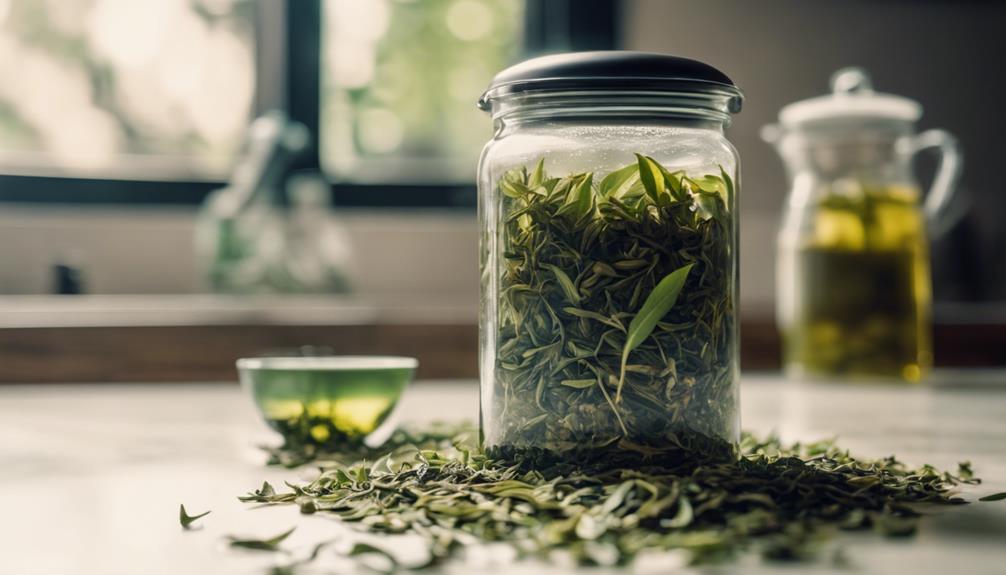
When exploring green tea leaves varieties, one encounters a diverse range of flavors and characteristics, from the sweet umami notes of Gyokuro to the bold, smoky profile of Gunpowder green tea. Each type of tea leaf offers a unique experience for your palate.
Here are some key varieties to ponder:
- Gyokuro: This high-quality shade-grown Japanese green tea is prized for its sweet, umami flavor.
- Sencha: A popular everyday green tea, Sencha boasts an invigorating, grassy taste and a vibrant green color.
- Matcha: Made from shade-grown tea leaves and ground into a fine powder, Matcha delivers a concentrated flavor and striking green hue.
- Dragonwell (Long Jing): Hailing from China, this famous green tea features a chestnut-like flavor and a smooth, sweet finish.
- Gunpowder: With its tightly rolled leaves resembling pellets, Gunpowder green tea offers a bold, smoky flavor with a subtle hint of sweetness.
Each of these tea leaves brings its own distinct characteristics to the table, catering to a wide range of preferences and palates.
Matcha Latte Recipe
You should explore the various points related to matcha latte, including a recipe for matcha ice cream.
The creation of matcha-infused cocktails is another exciting way to incorporate matcha into different culinary creations.
Techniques for making sous vide tea eggs provide a unique perspective on using matcha in cooking.
Each point offers a unique perspective on incorporating matcha into different culinary creations, expanding your understanding of this versatile ingredient.
Matcha Ice Cream Recipe
For a delightful treat that captures the essence of traditional Japanese flavors, whip up a batch of creamy matcha ice cream using this simple recipe.
- Matcha ice cream is a creamy dessert made with matcha powder, milk, sugar, and cream.
- It has a vibrant green color and a rich, earthy flavor with a hint of sweetness.
- Matcha ice cream is popular in Japan and has gained worldwide popularity for its unique taste.
- The recipe involves mixing the ingredients, churning in an ice cream maker, and freezing until set.
- Enjoy matcha ice cream on its own or as a topping for other desserts like waffles or pancakes.
Matcha-Infused Cocktail Creation
Enhance your mixology skills by incorporating the distinct flavors of matcha into your cocktail creations. Matcha-infused cocktails are gaining popularity for their unique taste and vibrant green color. Here are some key points to ponder when crafting a matcha latte cocktail:
- Flavor Fusion: Blend the earthy and grassy notes of matcha with complementary flavors for a well-balanced cocktail experience.
- Visual Appeal: The rich green hue of matcha adds an aesthetic touch to your cocktail presentation, enhancing its overall appeal.
- Customization Options: Experiment with different milk alternatives and sweeteners to tailor the matcha latte to various preferences.
- Balance is Key: Guarantee the flavors are harmoniously balanced to allow the matcha to shine without overpowering other ingredients.
- Creative Garnishes: Elevate the presentation with creative garnishes like matcha powder dusting or edible flowers for an extra touch of elegance.
Sous Vide Tea Eggs
Infusing tea leaves into sous vide-cooked eggs results in a delicate blend of flavors, adding a unique twist to the traditional matcha latte recipe. When it comes to making Sous Vide Tea Eggs, the following key points should be considered:
- Sous Vide Tea Eggs are immersed in a water bath for precise cooking.
- The regulated temperature in sous vide cooking guarantees a creamy texture.
- Tea leaves impart subtle flavors to the eggs during the cooking process.
- The resultant eggs have a smooth and silky consistency.
- Sous vide tea eggs can be a versatile addition to your menu, suitable for various occasions.
These eggs are a delightful treat, perfect for enhancing your culinary offerings with an infusion of tea flavors in hot water.
Tea Steeping Techniques
When steeping green tea with jasmine, it's essential to pay attention to the temperature control for best flavor extraction.
The duration of steeping time plays a significant role in the intensity of the tea's flavor profile.
Different methods of flavor extraction, such as adjusting water temperature or using different steeping techniques, can result in varied taste experiences.
Temperature Control for Tea
To achieve the perfect infusion of delicate green teas like Jasmine Green Tea, accurate temperature control is paramount for extracting ideal flavors and avoiding bitterness. Maintaining a consistent temperature, such as 175°F for Jasmine Green Tea, guarantees proper extraction without scorching or oversteeping.
Using sous vide for green tea steeping allows for precise temperature regulation, resulting in a more controlled and accurate brewing process. Temperature fluctuations during traditional steeping methods can lead to inconsistent flavor profiles, underscoring the importance of temperature control in tea preparation.
Sous vide technology provides a reliable way to achieve the ideal temperature for green tea brewing, ultimately enhancing the overall tea-drinking experience, especially when enjoying the delicate flavors of Jasmine Green Tea.
Steeping Time Importance
For a well-rounded green tea experience, mastering the art of steeping time is key, particularly when dealing with delicate varieties like Jasmine Green Tea. Steeping time greatly influences the flavor and aroma extraction in green tea. Longer steeping times can result in a bitter taste due to over-extraction, while shorter steeping times produce a milder flavor profile with less bitterness.
The best steeping time for green tea with jasmine typically falls around 2-3 minutes. By adjusting the steeping time, you can customize the strength and taste of the tea to suit your personal preferences. Paying attention to this essential aspect of tea preparation ensures that you extract the best flavors and aromas from your green tea, creating a delightful tea-drinking experience.
Flavor Extraction Methods
Steeping green tea with jasmine using the sous vide method guarantees precise temperature control for consistent and enhanced flavor extraction.
When utilizing a tea infuser, the sous vide technique allows for a controlled and gentle extraction process, preserving the delicate jasmine flavors.
By submerging the tea in water at a specific temperature for an extended period, the aromas are slowly released without the risk of bitterness.
The sous vide method enables the jasmine flowers to infuse thoroughly, resulting in a well-balanced and flavorful cup of tea.
This precise extraction process enhances the overall tea drinking experience by maximizing the aroma and taste of the jasmine, making it a delightful choice for tea enthusiasts seeking a refined and consistent brew.
Final Thoughts
As you contemplate the refined flavors and health benefits of sous vide green tea with jasmine, consider the unparalleled consistency and aromatic experience this brewing method delivers. When preparing sous vide green tea with jasmine, make sure to appreciate the enhanced delicate flavors that result from the precise temperature control, allowing for ideal extraction of both the tea and jasmine essence. This method guarantees that the antioxidants present in green tea leaves are retained, providing you with a healthful cup of tea every time.
One of the remarkable advantages of sous vide brewing is the consistent results it produces. By eliminating the risk of bitterness that can arise from traditional brewing methods, you can enjoy a perfectly balanced cup of jasmine green tea with every brew. The floral aroma and balanced tannins further enhance the overall tea-drinking experience, making sous vide green tea with jasmine a delightful choice for those who appreciate quality and precision in their beverages.
Frequently Asked Questions
What Temperature Do You Sous Vide Tea At?
When you sous vide tea, aim for precise control. Maintaining a specific temperature, like 175°F for green tea, is essential for ideal tea extraction. Consistent heat helps release flavors without bitterness. Enjoy your perfectly brewed tea!
How Do You Infuse Bourbon With Tea?
To infuse bourbon with tea, start by combining bourbon and tea leaves in a sealed container. Let it steep for hours to days for desired flavor. Use various teas like black, green, or herbal. Enjoy tea-infused cocktails or bourbon uniquely.
Conclusion
To sum up, sous vide green tea with jasmine offers a unique and flavorful twist to traditional tea brewing methods. By using precise temperature control, the delicate flavors of green tea leaves are enhanced, creating a rich and aromatic beverage.
Experimenting with different varieties of green tea leaves and exploring various steeping techniques can further elevate the tea drinking experience. Embrace the evolution of tea and indulge in the soothing and invigorating qualities of sous vide green tea with jasmine.
